Knee pain is an increasingly common problem for young athletes and may result from both
acute and
overuse injuries.
A variety of structures are particularly susceptible to injury among young athletes, including the bones that make up the knee joint (femur, tibia, and patella), the muscles and tendons that move the joint (quadriceps, patellar tendon and hamstrings), the cartilage that cushions the joint (medial and lateral meniscus) and the ligaments that stabilize the joint (medial collateral ligament, lateral collateral ligament, anterior cruciate ligament, and posterior cruciate ligament).
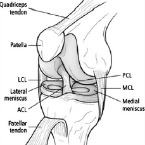
The use of knee braces is an important consideration for a variety of injuries, and may be intended for prevention or incorporated as part of a treatment plan. The goal of any knee brace should be to work together with the innate structures of the knee to reduce pain and promote stability without loss of normal knee function, thereby reducing injury risk.
Knee Braces: Types & Uses
Knee Sleeves

These are neoprene braces which slide over the knee. It may include padding over the kneecap, an opening for the kneecap, straps, and/or a buttress surrounding the kneecap. Basic sleeves provide warmth, compression, and perhaps an increased sense of knee support. They may be used in the treatment of patellofemoral pain or to reduce swelling. When a kneepad is included it provides additional protection to the front of the knee. It is important to recognize that while knee sleeves may help relieve swelling and provide a feeling of support following injury, they do not provide increased knee stability following injury or surgery.
Knee Pads
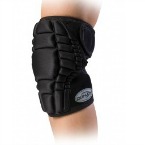
Knee pads may include knee sleeves with additional padding or rigid outer shells that cover the front of the knee with straps that wrap around the leg to secure it in place. Knee pads do not provide increased stability but may reduce injury risk, particularly in activities with the potential for direct blows to the front of the knee such as volleyball, skateboarding, biking, or roller skating.
Patellar Tracking Orthosis (PTO) Brace
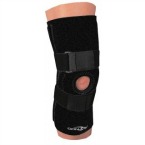
This brace involves a knee sleeve with an opening for the patella and straps or buttressing around the opening. This may limit movement of the patella, thereby reducing the likelihood of patellar subluxation or dislocation. They may also include hinge along the sides of the knee to provide an additional sense of stability. While definitive evidence is lacking, these braces may reduce pain for some individuals with patellofemoral pain due to improper tracking of the patella.
Patellar Straps (bands)
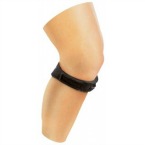
Patellar straps have become an increasingly popular and visible tool for addressing anterior knee pain in young athletes. Patellar straps should be positioned midway between the bottom of the kneecap and the bump on the shin, applying pressure to the patellar tendon that runs down the front of the knee and inserts on the lower leg. This is thought to relieve some of the stress on the tendon and its attachment on the tibia and may relieve pain associated with
patellar tendonitis and
Osgood-Schlatter disease.
Hinged Knee Braces
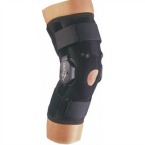
Unlike sleeves, these braces consist of one or two bars with hinges along the sides of the knee and straps to hold it in place. While there are a variety of different hinged braces, they are all designed to increase stability by supporting the ligaments along the inside or outside of the knee (medical and lateral collateral ligaments). Prophylactic knee braces are designed to prevent injury during contact sports. Although these are commonly worn and may reduce injury risk among a certain subset of athletes (football linemen, for example), it is not yet clear whether these are cost-effective or applicable to other sports.

Functional and postoperative knee braces can be either a combination of metal and plastic or foam liners that wrap around the upper and lower leg and with metal bars along both sides of the knee and hinges that can be adjusted to limit range of motion. They are intended to improve the stability of an injured knee and are most commonly worn following injury while awaiting surgical reconstruction, or after surgery to protect the reconstructed knee.They can be adjusted to allow various amounts of range motion, can accommodate swelling better than casts or splints, and are easy to remove and replace for icing and re-examinations.
Some Warnings for Parents about Knee Braces:
All knee bracing should be undertaken in consultation with your child’s doctor or
athletic trainer. While many varieties are available without a prescription, they should only be used once an accurate diagnosis has been made and a comprehensive management program has been developed.
For both acute and overuse injuries, knee braces should be only one element of a comprehensive treatment program. While some braces may protect the knee from further injury, rehabilitation that targets flexibility, strength, range of motion, and balance should be the mainstays of any recovery program.
The use of knee braces to prevent knee injuries should be considered carefully. This approach has not yet been shown to be cost-effective, and should not take the place of proper sport-specific training programs to reduce injury.
Additional Information: